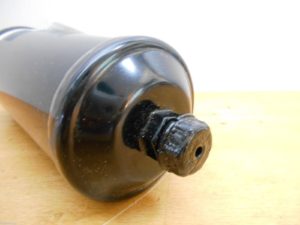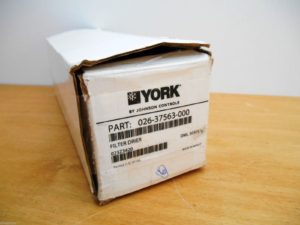York OEM 026-37563-000 Filter-driers are a key component in the refrigeration or air-conditioning systems.

026-37563-000
026-37563-000 A filter-drier in a refrigeration or air-conditioning system has two essential functions: one, to adsorb system contaminants, such as water, which can create acids that provide physical filtration. Evaluation of each of the factors is necessary to ensure proper and, of course, economical drier design.
Absorbing moisture and preventing acids with a 026-37563-000 FILTER DRIER
The ability to remove water from any refrigeration system is one of the most important functions of a 026-37563-000 drier.
 Water can come from many sources, including trapped air from improper evacuation, system leaks, and motor windings. Another source is the improper handling of hygroscopic polyol ester (POE) lubricants, which readily absorb moisture. POEs can pick up more moisture from their surroundings and hold it much tighter than other mineral oils. This water can then cause freeze-ups, which leads to the corrosion of metallic components.
Water can come from many sources, including trapped air from improper evacuation, system leaks, and motor windings. Another source is the improper handling of hygroscopic polyol ester (POE) lubricants, which readily absorb moisture. POEs can pick up more moisture from their surroundings and hold it much tighter than other mineral oils. This water can then cause freeze-ups, which leads to the corrosion of metallic components.
Water in any system will cause a reaction with these POEs called hydrolysis, resulting in organic acids’ formation.
To prevent the formation of these acids, the water within the system must be minimized. This is accomplished by the use of desiccants within the filter-drier. The three most commonly used desiccants are molecular sieve, activated alumina, and silica gel.
Selecting a desiccant
There are many factors involved when selecting which desiccant material is best for an application. Water capacity, refrigerant and lubricant compatibility, acid capacity, and physical strength are important characteristics of desiccants and should be considered.
The first of these, water capacity, is the amount of water the desiccant can hold while maintaining low moisture levels within the refrigeration system.
A molecular sieve retains the highest amount of water while keeping water concentration in the refrigerant flow. This is due to the strong bond between the molecular sieve and the water.
By keeping the water in the system at low levels, freeze-ups, corrosion, and acid formation is minimized. Activated alumina retains a fair amount of water, but the retention isn’t as great as the molecular sieve. This is indicative of the co-adsorption of other materials. Based on this information, Parker recommends using 100% molecular sieve in liquid line filter-driers for maximum water removal. Refrigerant and lubricant compatibility is also essential when selecting a desiccant.
Inorganic acids (HCl and HF) form from the refrigerant’s decomposition with an incompatible desiccant and water at elevated temperatures. Inorganic acids formed will attack the crystalline structure of the molecular sieve and break it down and attack metal surfaces in the system. Organic acids can form from the lubricant breakdown in an incompatible desiccant and water (elevated temperatures will increase this reaction).
Alumina can be more effective in removing the different acids when used in the system’s suction lines. When used in the liquid line of a system, there is always a potential for the hydrolysis reaction between the POE lubricant and water, resulting in organic acids’ formation. This reaction won’t occur if the alumina was tested in the suction line. Therefore, for acid cleanup in a system, the use of a suction line 026-37563-000 filter-drier containing an activated alumina core is often recommended.
Purchase a 026-37563-000 FILTER DRIER
